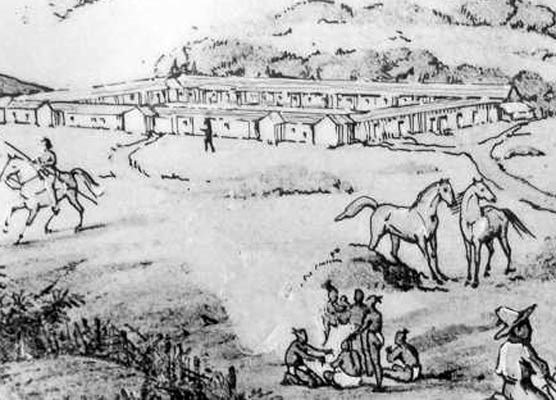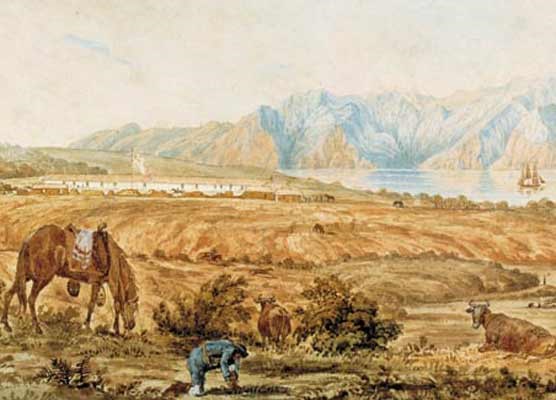What Was The Biggest Factor Leading To Spain Having Problems Controlling New Mexico And Texas?
Spanish Era 1776 - 1821
In an effort to solidify their control over North American resource and territory, European colonial powers began to construct fortifications to protect their settlements from strange encroachment. The Spanish empire had made several claims to California and sought to consolidate its position in N America equally a colonial power. Recognizing the significance of San Francisco Bay's vast harbor, Spain began to fortify the area with defensive structures.
Structure of the starting time defensive structure began in 1776. A lightly fortified military machine outpost, known as El Presidio de San Francisco in Spanish, was built simply within of the Golden Gate to provide protection for the garrisoned soldiers. This fortification and the others to follow were largely constructed using labor provided by indigenous people from the villages and missions of the Santa Clara Valley and San Francisco expanse. El Presidio was quite vulnerable to strange attach, because its lack of armament to defend itself against naval attack. The Spanish were aware of this vulnerability, and the growing tensions in the region would soon prompt them to accost their concerns.

Image courtesy of the Bancroft Library, University of California, Berekely, CA
In the years following the institution of the Presidio, Kingdom of spain and Keen Britain contested buying of the North America Pacific Coast. Both colonial powers attempted to settle their territorial dispute at the Nookta Convention of 1790. However, their efforts to reach an agreement were unsuccessful, and in 1792, the growing tensions between the two colonial powers became evident when British naval officer George Vancouver visited the Presidio of San Francisco and apprised his government of the lack of adequate defenses. In a reaction to this report and a growing concern for British territorial claims on the West Coast, Governor Jose Arrillaga order the construction of a coastal fortification to protect Espana's control of the harbor.
In 1793 work began on a land bombardment to protect the Bay of San Francisco at its narrow entrance. Located on La Punta de Cantil Blanco, or the point where the white bluffs overlook the 2-mile wide Gold Gate Straits from the southward, an adobe fort with 15 cannon embrasures was completed in December of 1794. The Spanish fort, which became the beginning coastal defensive structure on the western coast of Northward America, was named the Castillo de San Joaquin. A report in 1794 states that ordnance for the castillo and postal service included 800 cannon balls, "30 stands of grapeshot or canister, 52 arrobas and 7 ounces of pulverisation, 21 arrobas and ten ounces of pb foil for wrapping flints, seven arrobas and 24 ounces of musket assurance, 3,065 musket
cartridges made up, and 244 flints."
Non long after building the Castillo de San Joaquin, Spanish relations with Britain began to deteriorate. The tensions betwixt the two countries eventually erupted into a full-calibration war in 1797. The state of war spread speedily, and when the disharmonize reached the small settlement on San Francisco Bay, Governor Diego de Borica ordered an additional bombardment built 2 miles to the east of the Castillo, well inside the bay at a point with suitable anchorage (Fort Stonemason would be built at the same location in the future). First called Bateria San Jose, but later known as Bateria de Yerba Buena subsequently the proper name of a nearby cove, this outpost was constructed with eight embrasures, nevertheless it was simply equipped with five viii-pounder cannons at the fourth dimension of its completion.

Illustration courtesy of the Mr. and Mrs. Henry Due south. Dakin Collection
Mexican Era, 1822-1846
Although Spain had anticipated an assault on the pueblo on San Francisco Bay by the British, that assail was never realized. Ironically, the greatest threat to Spain's control of the region came from an unforeseen enemy which had also been a one-time marry. The Spanish colony of Mexico embarked on a war for independence in 1821. Post-obit a successful revolt later on that year, the Colony won its freedom from Spain. Alta California, which encompasses nowadays-twenty-four hours California, passed quietly into Mexican control.
Augmenting the fortification of the San Francisco Bay was a low priority for the new regime, and the defenses at Bateria Yerba Buena shortly barbarous into farther disrepair. A U.S. military report issued in 1841 revealed that only one rusty cannon was stationed at the derelict battery, and by 1846 the coastal fortifications at Bateria Yerba Buena were entirely abandoned by the Mexican military forces. At the nowadays time, no remains of this outpost are known to be.
In 1834, General Mariano Guadalupe Vallejo, who was the new comandante of the Presidio, moved office of the San Francisco garrison north to Sonoma. The move was partially precipitated by the dilapidated condition of the Presidio's adobe structures. The harm to the fort's structures, largely every bit a result of adverse conditions weather, was so severe that the fort needed to be almost entirely rebuilt. Notwithstanding, the Mexican government refused to fund the projection and the Presidio continued to deteriorate. By 1835, Vallejo had transported the last of the San Francisco garrison to the new northern outpost in Sonoma, leaving the security of the Presidio in the hands of a few caretakers.one
During the period of Mexican control of California, the increasing prominence in ocean commerce and an expanding migration of Anglo-American settlers into the region had aroused the territorial ambitions of the United states. In June of 1846, American settlers, supported by a contingent of ethnic Californians, revolted confronting the Mexican government of Alta California in a movement known every bit the Behave Flag Revolt. The The states backed the insurgents, which dispatched a pocket-size force to march south from Sonoma. The revolt was led by a Captain of Topographical Engineers, John C. Fremont, and included mountain man Christopher "Kit" Carson.
Only coming together lite resistance on their march to the pueblo of Yerba Buena, Fremont and his men apace reached the mouth of the San Francisco Bay, and crossed the harbor at its narrowest signal (the Castilian called the entry to the bay Boca del Puerto de San Francisco, merely in the following years Fremont used his influence as a topographer to rename the harbor's entrance Chrysoceras or Golden Gate, when translated from Latin into English). When the American forcefulness reached the shores of Yerba Buena, the few Mexican soldiers stationed at the Presidio fled at the sight of Fremont's men, leaving the Castillo de San Joaquin and the Presidio effectively abandoned. Just two hours subsequently the Americans landed on Yerba Buena, the entire armory of the Castillo, comprised of a number between ten and fourteen cannons, was rendered useless by a process known as "spiking."
The final assail on the Presidio came on July nine, 1846, when Captain John B. Montgomery of the U.Due south. sloop Portsmouth landed a strength of marines to seize the settlement of Yerba Buena, which would later get known equally San Francisco. At the Castillo de San Joaquin, the marines institute 3 brass guns that they believed to be 12 and 18 pounders, made in 1623, 1628, and 1693. In improver, seven iron guns were institute at the Castillo. The bronze guns that were recovered are believed to be the San Pedro, San Domingo, and La Birgen de Barbaneda. These guns are currently on display at the Presidio.
Today, the archaeological remains of El Presidio lie cached below the Presidio Master Mail service and inside the walls of the Presidio Officers' Club. Nothing remains of El Castillo or the above basis elements of Bateria de Yerba Buena, but the archaeology remains of the latter are unstudied.
To larn more nigh the early on history of the California coast and how the Castilian colonized this expanse, visit the National Register of Historic Places Travel Itinerary at https://world wide web.nps.gov/history/nr/travel/ca/alphabetize.htm
one. Dana, Richard Henry Jr. Ii Years Before the Mast: A Personal Narrative. Boston: James R. Osgood and Company, 1872.
What Was The Biggest Factor Leading To Spain Having Problems Controlling New Mexico And Texas?,
Source: https://www.nps.gov/goga/learn/historyculture/spanish-mexican-period.htm
Posted by: barnhartvishadep.blogspot.com


0 Response to "What Was The Biggest Factor Leading To Spain Having Problems Controlling New Mexico And Texas?"
Post a Comment